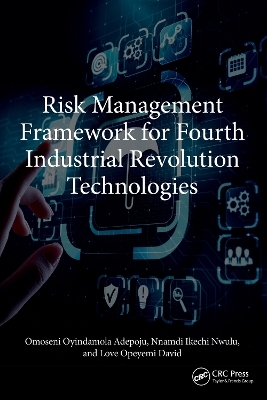
Risk Management Framework for Fourth Industrial Revolution Technologies
CRC Press (Verlag)
978-1-032-71377-9 (ISBN)
Features:
• Establishes a risk management framework for Industry 4.0 technologies.
• Provides a ‘one stop shop’ of different technologies emerging in the Fourth Industrial Revolution.
• Follows a consistent structure for each key Industry 4.0 technology in separate chapters.
• Details required risk management skills for the technologies of the Fourth Industrial Revolution.
• Covers risk monitoring, control, and mitigation measures.
This book is aimed at graduate students, technology enthusiasts, and researchers in computer sciences, technology management, business management, and industrial engineering.
Omoseni Oyindamola Adepoju holds the position of Associate Professor at Lead City University Ibadan, Nigeria. Additionally, she serves as a Senior Research Associate within the Faculty of Engineering and Built Environment at the University of Johannesburg, South Africa. Prof. Adepoju's expertise spans various areas, including re-skilling in the fourth industrial revolution, Construction 4.0, Industry 4.0, human capacity development, human capital in renewable energy, assessing skill gaps to meet the demands of Construction 4.0, evaluating innovative skills and management of Water, Energy and Food (WEF Nexus). Nnamdi Ikechi Nwulu holds the position of Professor of Sustainable Cyber-Physical Engineering Systems and serves as the Director of the Centre for Cyber Physical Food, Energy & Water Systems (CCP-FEWS) at the University of Johannesburg. Additionally, he is the Chairholder of the South Africa/ Switzerland Bilateral Chair in Blockchain Technology (SARChI Chair). His research endeavors concentrate on the practical applications of digital technologies, mathematical optimization techniques, and machine learning algorithms within food, energy, and water systems. Love Opeyemi David is an interdisciplinary social scientist, proficient in Project Management, Resource Management, Management science, Technology Management, and Innovation Management. His diverse research interests encompass Project Management, Innovation Management, Management Science, Water-Energy-Food (WEF) Nexus Project Delivery, Circular Economy, Sustainable Development/Sustainability, and cutting-edge technologies of the Fourth Industrial Revolution (including Blockchain technology, Internet of Things, Artificial Intelligence, etc). He is currently the Managing Editor of the Journal of Digital Food, Energy and Water Systems (JDFEWS).
PART I. Introduction and Background. Chapter 1. Introduction. 1.1 Background to the Study. 1.2 Aim and Objectives. 1.3 Organization of the book. 1.4 Contribution and Value. 1.5 Summary. 1.6 References. Chapter 2. The Fourth Industrial Revolution. 2.1 Introduction to the Fourth Industrial Revolution. 2.2 Overview of Risks in the Fourth Industrial Revolution. 2.3 Categories of Risks in the Fourth Industrial Revolution. 2.4 Impacts of the Risks of the Fourth Industrial Revolution. 2.5 Summary. 2.6 References. Chapter 3. Introduction to Risk Management and Current Risk Management Framework. 3.1 Introduction to Risk Management. 3.2 Risk Identification Process. 3.3 Risk Response Planning and Techniques. 3.4 Qualitative and Quantitative Risk Analysis. 3.5 The PESTLE Analysis. 3.6 Risk Monitoring and Control. 3.7 Summary. 3.8 References. PART II. Risks of the Fourth Industrial Revolution Technologies. Chapter 4. Artificial Intelligence. 4.1 Introduction to and Components of Artificial Intelligence. 4.2 Risk Associated with Artificial Intelligence. 4.3 Risk Management Techniques for Artificial Intelligence. 4.4 Risk Management Skills for Artificial Intelligence. 4.5 Summary. 4.6 References. Chapter 5. The Internet of Things. 5.1 Introduction to and Components of the Internet of Things. 5.2 Risks Associated with the Internet of Things. 5.3 Risk Management Techniques in the Internet of Things. 5.4 Risk Management Skills for the Internet of Things. 5.5 Summary. 5.6 References. Chapter 6. Blockchain Technology. 6.1 Introduction to and Components of Blockchain Technology. 6.2 Risk Associated with Blockchain Technology. 6.3 Risk Management Techniques for Blockchain Technology. 6.4 Risk Management Skills for Bockchain Technology. 6.5 Summary. 6.6 References. Chapter 7. Cloud Computing. 7.1 Introduction to and Components of Cloud Computing. 7.2 Risks Associated with Cloud Computing. 7.3 Risk Management Techniques in Cloud Computing. 7.4 Risk Management Skills for Cloud Computing. 7.5 Summary. 7.6 References. Chapter 8. Robotic Technology. 8.1 Introduction to and Components of Robotics. 8.2 Risk Associated with Robotics. 8.3 Risk Management Techniques in Robotics Technology. 8.4 Risk Management Skills for Robotics. 8.5 Summary. 8.6 References. Chapter 9. Augmented/ Virtual Reality. 9.1 Introduction to and Components of Augmented/Virtual Reality. 9.2 Risks Associated with Augmented/Virtual Reality. 9.3 Risk Management Techniques in Augmented/Virtual Reality. 9.4 Risk Management Skills for Augmented/Virtual Reality. 9.5 Summary. 9.6 References. PART III. Risk Management Framework for Fourth Industrial Revolution Technologies. Chapter 10. Risks Management Framework. 10.1 Overview of Risk of Fourth Industrial Revolution Technologies. 10.2 Legal, Political, and Social-Environmental Risks. 10.3 Risk Mitigation Measures. 10.4 Risk Management Framework for Fourth Industrial Revolution Technologies. 10.5 Summary. 10.6 References.
| Erscheinungsdatum | 11.09.2024 |
|---|---|
| Zusatzinfo | 4 Tables, black and white; 34 Line drawings, black and white; 1 Halftones, black and white; 35 Illustrations, black and white |
| Verlagsort | London |
| Sprache | englisch |
| Maße | 152 x 229 mm |
| Gewicht | 512 g |
| Themenwelt | Mathematik / Informatik ► Informatik ► Netzwerke |
| Mathematik / Informatik ► Informatik ► Theorie / Studium | |
| Mathematik / Informatik ► Informatik ► Web / Internet | |
| Technik ► Bauwesen | |
| Wirtschaft ► Betriebswirtschaft / Management ► Logistik / Produktion | |
| Wirtschaft ► Volkswirtschaftslehre | |
| ISBN-10 | 1-032-71377-1 / 1032713771 |
| ISBN-13 | 978-1-032-71377-9 / 9781032713779 |
| Zustand | Neuware |
| Informationen gemäß Produktsicherheitsverordnung (GPSR) | |
| Haben Sie eine Frage zum Produkt? |
aus dem Bereich


